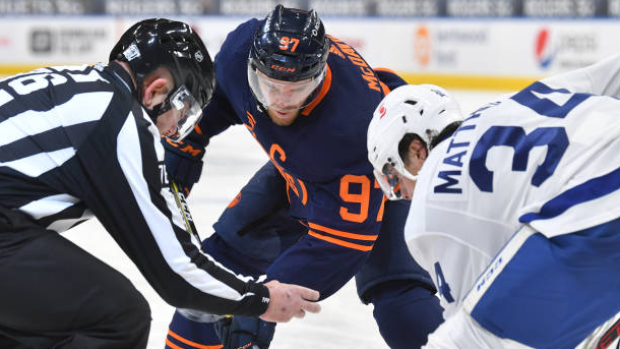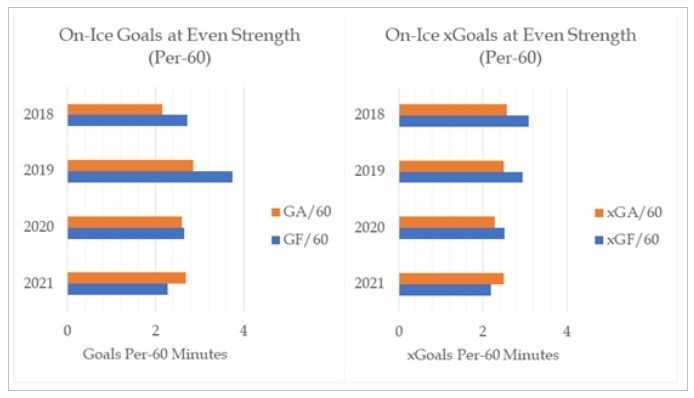Sep 7, 2021
Grading the centres on Canada’s NHL teams
With NHL training camps set to open in only a couple of weeks, Travis Yost looks at where the league's seven Canadian teams stand in terms of depth down the middle headed into the 2021-2022 season.
By Travis Yost

We are two weeks away from the opening of NHL training camps. From there, it’s a hop, skip, and a jump to the preseason exhibition schedule and opening night of the 2021-22 regular season.
Roster-building efforts for the most part are done, and front offices now hand the keys over to the coaching staff for lineup creation and optimization. And though expectations can be quite different from market to market – compare the pressure in places like Toronto and Edmonton versus that of Ottawa right now – all are expected to improve on last season.
To get a feel for what these lineups might look like, we will spend the next two weeks previewing the depth charts of all seven Canadian teams and grading each position accordingly. Today’s focus will cover what I consider to be the strength of the Canadian clubs: the centre position.
As a refresher, look at the expected depth charts for the centre position across the teams. The below table has multi-year usage and productivity rates (as measured by Goals Above Replacement) as measured against their peers. Most of these are household names at this point, but new faces – like Ottawa’s Shane Pinto and Montreal’s recent acquisition Christian Dvorak – will add a wrinkle when evaluating the position:

Now, the grades.
Edmonton Oilers (A)
The Oilers have the best one-two centre punch in the National Hockey League in Connor McDavid and Leon Draisaitl. The fact that McDavid and Draisaitl both went supernova for multiple seasons now despite middling defensive numbers – sixth and 18th percentile in rate goals-against over the last two seasons, respectively – is a testament to how electric they are on the attack.
It’s also yet another reminder that the opportunity for the Oilers to turn into a dominant hockey team is still there, despite painstaking years of futility. Merely average defensive play with Edmonton’s top-six forwards on the ice would turn the core parts of this roster into a machine.
The trick for head coach Dave Tippett is to build structural reliability into this group’s off-puck play without handcuffing them in the offensive zone. This group was meant to play with lightning-quick pace in transition, and when they do, they can be unstoppable.
The bottom six (likely owned by Derek Ryan and Kyle Turris) leaves a bit to be desired, but Ryan does bring some defensive credibility to a checking line. The Oilers will need a bounce-back season from Turris, whose play earned him routine healthy scratches last season.
Toronto Maple Leafs (B+)
If there’s another Canadian one-two punch down the middle that can rival Edmonton’s it’s Auston Matthews and John Tavares in Toronto. What’s interesting is how different the Maple Leafs go about finding their success in the offensive zone relative to the Oilers.
Matthews is perhaps the best shooter of the puck in the league and benefits from playmaking off the wings, and sometimes you see the Maple Leafs play a bit of outside-in when attacking the defence.
Tavares likes to have the puck on his stick, working his way in and out of space. His best goal-scoring season (47 in 2018-19) was a byproduct of fantastic chemistry between him and elite forechecker and puck retriever Zach Hyman, whose dirty work allowed Tavares to work into the low slot and interior for shooting opportunities.
Pierre Engvall is a quality piece further down the lineup, but I do think there’s some risk with this position group. The team needs Jason Spezza (who may see time at both wing and centre) to have another strong season. Spezza was one of the team’s most effective skaters in very limited minutes last year, but he is 38-years-old and can struggle with pace against tougher competition.
Of course, the Maple Leafs can address this by tagging Alex Kerfoot for third-line centre duty. I think this is one of the two biggest unknowns at the position amongst these seven teams – we saw Kerfoot play extended time on the wing on the Tavares line, but he also centered a line featuring Alex Galchenyuk and William Nylander last season. This will remain an unknown for now.
The David Kampf bet is, in one word, interesting. Since entering the league, Kampf’s line has averaged just 1.6 goals per 60 minutes of play, third-worst in the league (behind Tobias Rieder and Chris Wagner). If this ends up being a losing bet, there’s a decent-sized hole on the Maple Leafs fourth line.
Vancouver Canucks (B+)
Elias Pettersson is a star at the age of 22. Bo Horvat and Jason Dickinson are quality middle-six centres at the age of 26. For whatever ails the Canucks (and you can find most of those problems here), this team is built from the inside-out, and their ability to chase down a playoff spot in an otherwise weak Pacific Division hinges on this group to deliver.
The area of focus for head coach Travis Green will concern the second line – if not because Pettersson has already shown he can elevate the play of whatever wingers are on his hip, then because the second line is where organizational change has been realized.
The Canucks entered this off-season trying to accomplish two competing objectives: improving the talent around the roster while also managing out serious salary cap risk from a heap of relatively overpaid players. That strategy evolved into a mega-deal, where the Canucks moved a small army of resources to the Coyotes in exchange for defenceman Oliver Ekman-Larsson and winger Conor Garland.
Garland (who has averaged 24 goals per 82 games in his career) adds offensive pop on the wing that teammate Tanner Pearson may not be able to provide; similarly, acquiring Garland means the Canucks might be able to push promising 20-year-old left wing Nils Hoglander into an entrenched third-line position against weaker competition.
At any rate, Green has some flexibility in the middle six he didn’t have last year.
Winnipeg Jets (B)
This season really – and I mean really – comes down to whether or not Pierre-Luc Dubois can look like the player we saw in Columbus.
The Jets were wildly ineffective with Dubois’ line on the attack last season. And it wasn’t for a lack of effective top-six wingers with him – Dubois played most of his minutes with Nikolaj Ehlers and Kyle Connor, both of whom were near point-per-game players in 2020-21.

It also wasn’t about poor shooting luck. The Jets were just less threatening as a group with Dubois deployed, and I suspect some of that is the net result of the Jets spending too much time defending the run of play in the neutral and defensive zones.
The other reason Dubois’ second season is so important is it really makes or breaks this positional group. The Jets’ road to success, even with some improvements made on the blueline, really comes down to unleashing waves of capable forward lines and having the ultimate eraser in transition in one Connor Hellebuyck.
Moreover, players like Riley Nash and Adam Lowry have an exceptionally muted upside, considering their skill sets and respective ages.
Calgary Flames (C+)
The problem for the Flames isn’t the lack of competency at the centre position – Elias Lindholm, Sean Monahan, and Mikael Backlund all have realized success at this level. The problem is there is no insulation at the position from a higher end first-line talent.
Lindholm has fit in seamlessly between Johnny Gaudreau and Matthew Tkachuk, but the coaching staff is still trying to figure out what works on the Monahan and Backlund lines. This is an important question for the Flames to answer: both of Calgary’s middle-six forward lines were underwater in goals last year, in part because of the calibre of competition they are facing. Monahan’s most common opponent? John Tavares. Backlund’s most common opponent? Connor McDavid.
There is another reason they need to solidify these lines. The fourth-line centre position is wide open – so much so, I think it’s impossible to do anything but pencil a name into the slot. Any of Byron Froese, Trevor Lewis, Glenn Gawdin or Adam Ruzicka could see time. Compared to what other teams are dressing in their bottom six, this group will likely struggle.
Montreal Canadiens (C)
Well, a lot has happened here!
I don’t think there is any argument the Canadiens are better down the middle after swapping Jesperi Kotkaniemi for Dvorak. Carolina made a fascinating bet on Kotkaniemi, providing a blueprint for how offer sheets may work in the future.
Kotkaniemi may ultimately end up being the two-way dynamo the Hurricanes think he can become. But Montreal, if they are serious about returning to the postseason this year, knows the 25-year-old Dvorak is further along in development. Just last season, Dvorak tallied 39 points in 49-games; on a rate-basis, that puts him in the 82nd percentile, comparable to New York’s Mika Zibanejad and San Jose’s Tomas Hertl.
But the future of this position in Montreal will hinge on how great of a player Nick Suzuki becomes. Suzuki looked great last postseason as a 22-year-old against elite competition, scoring 16 points in 22 games.
It will be interesting to watch here is if head coach Dominique Ducharme rolls out his postseason line combinations to start the regular season; Suzuki’s play with Josh Anderson and Jonathan Drouin was fine, but I thought he developed instant chemistry with rookie sensation Cole Caufield in the playoffs. That’s a tandem that makes sense and should scare the rest of the Atlantic Division.
Ottawa Senators (C-)
There is Chris Tierney, a reliable third-line centre who can give you 30-40 points in a season and will eat up the lion’s share of penalty killing minutes for D.J. Smith. And then there are a lot of unknowns.
Two promising unknowns are Josh Norris and Pinto. Norris’s rookie season looked impressive considering the circumstances – it’s not easy to score 51 points (pro-rated) on a roster that devoid of talent, but it was an important milestone for the former first-round pick.
The Senators have grown increasingly excited about Norris’ long-term future after successful stints at the University of Michigan and with AHL Belleville; a strong rookie year in a season where the team’s primary goal involved a lottery pick only strengthens the confidence.
Pinto, meanwhile, had a cup of coffee last season with Ottawa (12 games) after a fantastic second season with the University of North Dakota (32 points in 28 games).
On the other end of the spectrum is Colin White. White is still just 24, but I think general manager Pierre Dorion and the Senators organization have been wanting more from him in the offensive third. The individual scoring just isn’t there, and playmaking through his wingers has been limited.
White’s 33 goals in 200 games is the sort of simple yet effective measure that forces front offices to reconsider what they have (or in this case, don’t have) in a player. White has been able to stick in the lineup because he’s competitive and plays hard away from the puck, but that six-year contract he signed in 2018-19 is starting to draw some scrutiny.
This group, like most of the Ottawa roster, has a lot of upside. But they are the weakest of the Canadian clubs heading into next season.
Data via Natural Stat Trick, NHL.com, Evolving Hockey, Hockey Reference, Hockey Viz

